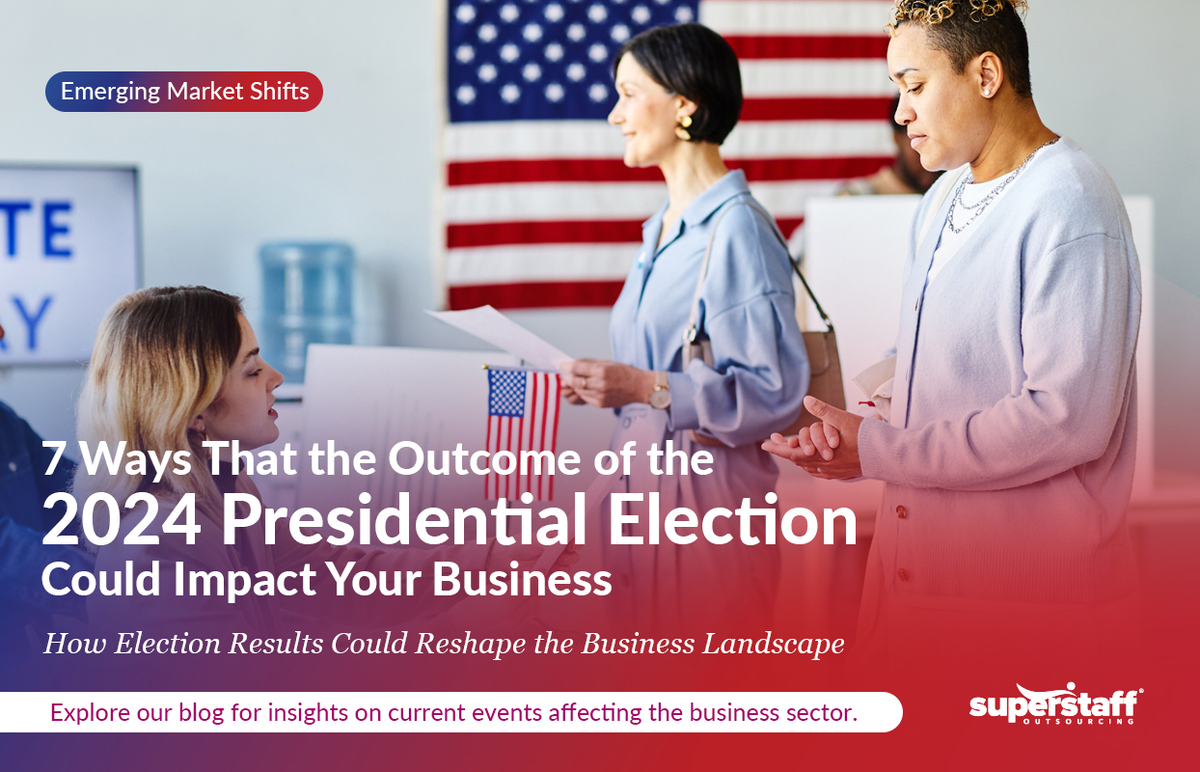
With the results of the 2024 presidential election now in, businesses are preparing for what could be a transformative shift in the country’s political and economic landscape.
Every new administration brings a unique set of priorities that introduces both challenges and opportunities. Whether you lead a small or multinational firm, the policies and decisions from Washington, D.C., will influence how you do business. The stakes are high, with new approaches likely to affect taxes, global trade, and the cost of operations.
This article explores seven key areas where the election outcome could impact your firm. From trade relationships to labor laws and infrastructure investment, staying informed and proactive is essential.
Note:
This article was first published on September 16, 2024, and last updated on November 6, 2024.

1. Tax Policy Post-Election Changes
Tax policy is often one of the first areas to see changes when a new president takes office. These adjustments can significantly affect businesses, as corporate tax rates and capital gains taxes influence profitability and broader economic growth.
Corporate Tax Rates: A Double-Edged Sword
The next president’s stance on corporate tax rates could significantly influence your business.
Higher corporate tax rates typically reduce business profitability, making them unfavorable to many businesses. However, such increases also raise government revenue, which can be invested in public infrastructure and services. This can create new business opportunities for sectors like construction and engineering as governments invest in roads, bridges, and other public works projects.
That said, higher corporate taxes also come with challenges. You must rethink your investment strategies and adjust profit expectations, as the tax burden can eat into your margins.
Capital Gains Taxes: Shaping Investor Behavior
Additionally, capital gains taxes play a critical role in shaping investment decisions. When these taxes increase, investors are forced to shift from high-growth stocks to more stable value stocks to minimize their tax burden.
Conversely, lower capital gains taxes encourage investment in growth stocks and speculative ventures, potentially driving market valuations and stimulating economic growth. For sectors like real estate and technology, where capital gains play a significant role, even small changes in tax policy can have far-reaching consequences.
Understanding these tax policy implications will be crucial for your business planning and investment decisions as the new administration takes shape.
The Expiration of the 2017 Tax Cuts and Jobs Act (TCJA)
Another significant tax policy issue you should track is the 2017 Tax Cuts and Jobs Act (TCJA) expiration after 2025 — without which most U.S. taxpayers (62%) could face tax increases.
Trump’s tax plan stimulates economic growth by increasing tax cuts for individuals and businesses. His proposal also includes an expanded child tax credit and the elimination of taxes on tips, targeting specific groups of workers to encourage spending and investment.
Harris’s tax reform ideas are currently less detailed, but she has openly supported expanding the child tax credit.
Future Tax Strategies
The direction of U.S. tax policy hinges on the outcome of the 2024 election. As the tax landscape evolves, your profitability, investment strategies, and growth opportunities will be directly impacted. Being proactive in adjusting your financial planning, such as preparing for potential increases in corporate taxes or capital gains, will help you mitigate risks and seize new opportunities, especially in sectors that benefit from government investments.
In short, having a flexible strategy is essential to maintaining a competitive edge.
2. Regulatory Environment: Navigating Shifts in Compliance
The regulatory environment in the United States is dynamic and often unpredictable, often fueled by the dynamic political climate. These changes profoundly impact industries from energy and finance to healthcare and labor. Amid the presidential election of 2024, you must examine how these policy shifts will affect your compliance strategies.
Impact of Regulatory Shifts on Industries
A Trump presidency will usher in a deregulation period characterized by reduced federal oversight and a more business-friendly environment. His approach to regulation often involves rolling back existing rules and implementing policies to reduce bureaucratic hurdles. This could increase operational flexibility, particularly in sectors like technology and energy, where innovation thrives in less stringent environments.
Meanwhile, a Harris administration might adopt a more aggressive regulatory stance, focusing on tightening rules in sectors such as finance and technology. She has previously supported stricter financial regulations and oversight of emerging technologies like artificial intelligence and cryptocurrency.
While such policies may add to business compliance costs, they are guaranteed to boost consumer protection and operational transparency. For instance, in the financial sector, stringent regulations will help prevent fraud and ensure ethical practices for increased consumer trust and market stability.
Effects of Labor Law Changes
The outcome of the upcoming election could also determine the future of labor policies.
Changes in minimum wage requirements, overtime regulations, and other labor-related policies will impact a company’s cost structure and workforce management strategies. For example, increases in minimum wage can lead to higher operational costs for industries with large numbers of low-wage employees, such as retail and hospitality. On the other hand, changes to improve labor conditions might enhance employee satisfaction and productivity, leading to long-term benefits for businesses.
Whether it’s a deregulatory approach that provides operational flexibility or a more stringent regulatory environment that enhances consumer trust, these shifts can directly impact your industry. Additionally, potential changes to labor laws will affect how you manage costs and your workforce. By adapting your compliance strategies and workforce management accordingly, your business can remain resilient and ready to capitalize on opportunities regardless of the political outcome.
3. Trade Policies: The Ripple Effect on Global Supply Chains
A comparison of the potential trade policies under Harris and Trump reveals starkly different approaches that could redefine the landscape of international trade.
Harris’s Trade Policy
A collaborative stance on international trade characterizes Harris’s approach.
Instead of resorting to aggressive tariffs, she is expected to prioritize diplomatic negotiations. Her strategy involves fostering international alliances and resolving trade disputes through cooperation rather than confrontation. A key component of her policy is the focus on strengthening domestic production. Harris aims to boost American manufacturing and diversify global supply chains by investing in infrastructure and technology, ensuring the U.S. can better support its domestic industries.
Additionally, Harris is likely to advocate for modernizing trade agreements. She plans to push for updates to agreements like the United States-Mexico-Canada Agreement (USMCA), incorporating stronger environmental protections and labor rights into these deals. Her trade policies will emphasize environmental sustainability, promote green technologies, and address climate goals.
Donald Trump’s Trade Policy
In contrast, Trump’s trade policy is expected to be more protectionist. He will likely continue his “America First” agenda, using tariffs as a primary tool to address trade imbalances, particularly with China. Trump’s strategy may involve proposing new tariffs to protect U.S. industries further and incentivize domestic production. He will focus on reshoring manufacturing and reducing reliance on foreign supply chains.
Trump’s approach also includes renegotiating or exiting trade agreements he views as unfavorable, aiming to secure better terms for U.S. industries. He would likely adopt an aggressive stance in handling geopolitical conflicts, using trade policy and sanctions to assert U.S. interests and address international disputes.
As companies seek to diversify their supply chains, the stability of trade agreements becomes a critical factor in long-term planning. The election’s outcome will significantly shape these dynamics, influencing how businesses navigate the evolving global trade environment.
Preparing for changes in trade policy will be crucial to navigating the global market. Harris’s focus on diplomacy and modernizing trade agreements may open up new opportunities for companies involved in sustainable technologies and international partnerships. However, you’ll also need to stay agile if trade protections and tariffs are reintroduced under Trump, as they could impact supply chains and increase costs for imported goods.
4. Healthcare Policy Shifts: Impacts on Employer-Sponsored Insurance and the Broader Healthcare Industry
As we approach the US presidential election 2024, healthcare reform remains a crucial issue that could significantly influence employer-sponsored insurance and healthcare. The political climate and the resulting policy shifts can reshape costs, regulations, and business strategies, impacting how companies manage employee benefits and health-related expenses.
Rising and Falling Costs
Healthcare policy changes will significantly impact the costs of employer-sponsored insurance. Depending on the administration’s direction, businesses might see premiums and coverage requirements fluctuations. For instance, past healthcare reforms, such as the Affordable Care Act (ACA) or Obamacare, increased premiums for some while expanding coverage for others.
Impact on Sensitive Sectors
Sectors like pharmaceuticals and insurance are particularly susceptible to shifts in healthcare policy. Changes in regulatory requirements or reimbursement rates can significantly affect these industries. The Trump administration’s approach to the ACA included policies that altered insurer reimbursements and funding, impacting the pharmaceutical and insurance sectors. Similarly, the Biden-Harris administration’s initiatives to restore funding and increase subsidies have influenced these industries’ financial dynamics.
Adjusting Hiring Strategies
Fluctuating healthcare costs in the post-election era may force employers to reconsider their hiring strategies. At the same time, increased insurance premiums prompt them to adjust workforce size or explore alternative benefit structures.
Companies might also implement Health Savings Accounts (HSAs) or opt for more cost-effective insurance plans to balance financial constraints while maintaining competitive employee benefits. Additionally, adapting hiring practices to manage these costs effectively is vital for sustaining business operations and employee satisfaction.
Depending on the election outcome, you may face fluctuations in premiums and coverage requirements, affecting your budget and employee benefits planning. Sensitive sectors like pharmaceuticals and insurance might experience shifts in regulations and funding, influencing their financial dynamics. To navigate healthcare trends and changes, consider evaluating your hiring strategies and exploring cost-effective insurance options or Health Savings Accounts (HSAs). Adapting to these potential shifts will be essential for maintaining financial stability and competitive employee benefits in a changing healthcare landscape.
5. Changes in Energy and Climate Policies
The upcoming election day is also make or break for Biden-era climate and energy regulations, potentially determining whether current policies will continue or face reversals.
Achievements and Challenges Under the Biden Administration
Substantial advancements have been made in climate policy under President Joe Biden, such as the Inflation Reduction Act, which allocates $370 billion for energy and climate initiatives. This legislation targets greenhouse gas emissions across various sectors, including electricity, transportation, and oil and gas.
Potential Outcomes
Should Kamala Harris win the 2024 election, she would likely continue defending and implementing Biden-era regulations. This would involve focusing on legal defenses, completing pending rules, and maintaining the trajectory of existing climate policies. Meanwhile, a Trump victory could lead to a rollback of many of these regulations. His administration is expected to emphasize energy dominance, potentially issuing executive orders to swiftly dismantle current policies.
Regulatory Uncertainty and Its Implications for Energy Companies
This political climate creates substantial regulatory uncertainty for energy companies.
The possibility of a regulatory shift under a new administration means businesses must navigate a volatile environment with unpredictable rules. Energy independence policies could reduce domestic energy costs by lessening reliance on foreign sources, but they might also cause disruptions in global energy markets, affecting energy prices and availability worldwide.
Opportunities for Businesses Investing in Green Initiatives
Moreover, under the new administration’s policies, businesses that invest in green technologies and sustainable practices may benefit from tax incentives and subsidies to support the transition towards more environmentally friendly operations. Such financial incentives can help offset the costs of adopting new technologies and contribute to long-term savings, aligning with broader sustainability goals.
Broader Economic Implications
Ultimately, environmental and energy policy changes affect operational costs and intertwine with overarching economic policies that influence monetary policy and inflation. If Harris wins, expect continued support for green initiatives and potentially favorable tax incentives for sustainable practices. Conversely, a Trump victory could usher in a rollback of existing regulations, possibly affecting energy prices and availability.
Navigating this uncertainty requires staying adaptable and proactive, especially if you’re involved in green technologies or energy sectors. Understanding these potential changes will be key to aligning your business strategies with evolving policies and maintaining economic stability.
6. The Federal Reserve’s Future: Economic Policy and the 2024 U.S. Presidential Election
The election results will determine the fate of the Federal Reserve’s role in managing inflation and economic stability. Here’s a deep dive into how the two leading candidates —Trump and Harris — could shape the Fed’s approach and the broader financial landscape.
Trump’s Potential Impact on Inflation and Fed Policy
Former President Donald Trump’s return to the White House could present fresh challenges for the Federal Reserve’s current inflation-control efforts. Economists predict that Trump’s economic policies could reignite inflationary pressures, forcing the Fed to implement more restrictive monetary policies than anticipated.
An Oxford Economics model forecasted inflation, excluding food and energy prices, which could peak between 0.3 and 0.6 percentage points higher under a Trump administration than current projections. This contrasts sharply with the predicted inflation under a Democratic administration, where inflation might only exceed current expectations by 0.1 to 0.2 percentage points.
Harris’s Hallmark: Stability and Fed Independence
Meanwhile, Harris has pledged to uphold the Federal Reserve’s independence and avoid interfering with its decisions. This commitment is seen as a stark contrast to Trump’s approach.
Harris has emphasized that, unlike Trump, she would not meddle in the Fed’s monetary policy decisions. Moreover, her economic platform is expected to focus on controlling costs and supporting economic growth without disrupting the Fed’s operations. Her campaign aims to address voter concerns about high prices and financial management, presenting a more predictable and less contentious approach to economic policy.
A Critical Juncture for U.S. Economic Policy
As the U.S. approaches the election, the contrasting economic policies of Trump and Harris highlight the critical role of presidential leadership in shaping the Federal Reserve’s actions and the broader economic environment. Trump’s potential return to office could introduce significant inflationary pressures and require a more restrictive Fed policy. At the same time, Harris’s commitment to Fed independence promises a more stable and predictable economic landscape. The outcome of this election will be pivotal in determining the future direction of U.S. monetary policy and the Fed’s approach to managing inflation and growth.
Understanding these dynamics is crucial for investors, policymakers, and businesses as they prepare for potential shifts in economic policy and market conditions. Adjusting investment strategies and preparing for changes in economic conditions will ensure that you remain resilient in a fluctuating economic landscape.
7. Trump vs. Harris: How Presidential Immigration Policies Will Shape Workforce Availability
Immigration policies directly impact workforce availability and talent acquisition, especially for industries dependent on skilled labor.
The presidential candidates’ immigration policies can significantly shape how businesses recruit and retain talent, particularly in sectors that rely heavily on skilled workers, such as technology, engineering, and agriculture. Trump and Harris’s proposals present two distinct visions for U.S. immigration policy, each with potential implications for the workforce.
Trump’s Proposals
- Border Security: Trump emphasizes stringent border enforcement, advocating for the border wall’s completion and increased border patrol funding. This focus on security could impact labor availability by making it harder for workers from abroad to enter the U.S., potentially exacerbating shortages in industries that rely on foreign talent.
- Deportation Policies: He supports aggressive deportation of undocumented immigrants and the elimination of sanctuary cities. These policies could lead to decreased available labor, particularly in sectors such as agriculture and construction, which depend on many undocumented workers.
- Merit-Based Immigration: Trump favors a merit-based immigration system prioritizing skilled workers over family reunification. This approach could benefit industries needing specialized skills but also restrict the flow of less-skilled labor, affecting sectors with broader workforce needs.
Harris’s Proposals
- Pathway to Citizenship: Harris proposes a pathway to citizenship for undocumented immigrants who have lived in the U.S. for an extended period. This policy could stabilize the workforce by allowing long-term residents to remain legally, benefiting industries that depend on experienced workers.
- Dismantling of ICE: She suggests reevaluating ICE’s role and practices in advocating for more humane treatment of migrants. This shift could reduce the fear of deportation and encourage a more inclusive workforce, leading to a more stable labor market in sectors reliant on migrant workers.
- Support for Refugees: Harris emphasizes robust support for refugees and asylum seekers. Her approach could enhance the availability of diverse talent and contribute to filling gaps in industries facing skill shortages, contrasting sharply with Trump’s restrictive measures.
Amid the global talent shortage, the stark differences between Trump’s and Harris’s immigration policies highlight broader ideological divides that will shape the future of U.S. workforce dynamics.
Trump’s focus on stringent border security and a merit-based immigration system could lead to increased challenges in recruiting skilled and less-skilled labor, potentially exacerbating talent shortages in key industries. Conversely, Harris’s proposals for a pathway to citizenship and support for refugees may stabilize the workforce and expand talent pools, benefiting sectors reliant on diverse and experienced workers. Preparing for these potential changes will be essential for managing workforce planning and ensuring that you can navigate the evolving landscape of immigration policy effectively.

Stay Informed With SuperStaff
The outcome of the U.S. presidential election 2024 can impact the business sector, influencing everything from tax policies to workforce dynamics. Staying informed is critical for navigating tax reforms, adapting to regulatory changes, or strategizing in response to evolving immigration policies.
At SuperStaff, we’re dedicated to helping you understand these complex dynamics and how they can shape your business strategies. Our expert analysis and updates ensure you can capitalize on new opportunities and mitigate potential risks.
Don’t let political changes catch you off guard. Follow SuperStaff on LinkedIn and subscribe to our newsletter for the latest insights and updates delivered directly to your inbox. Stay ahead of the curve and position your business for success in an ever-changing political environment.






